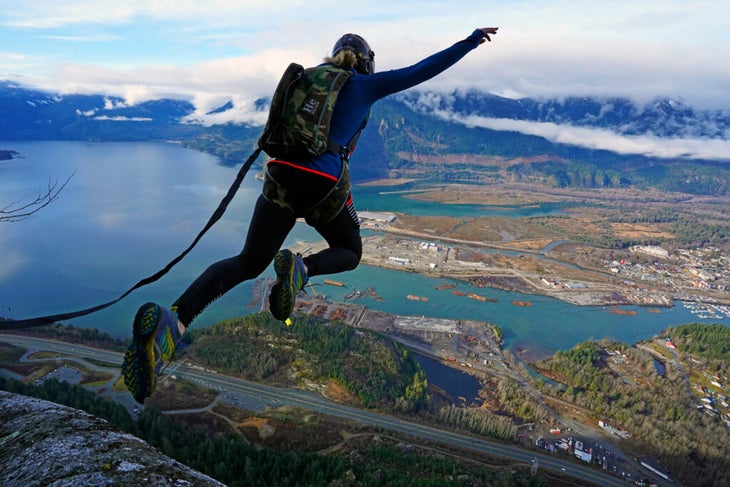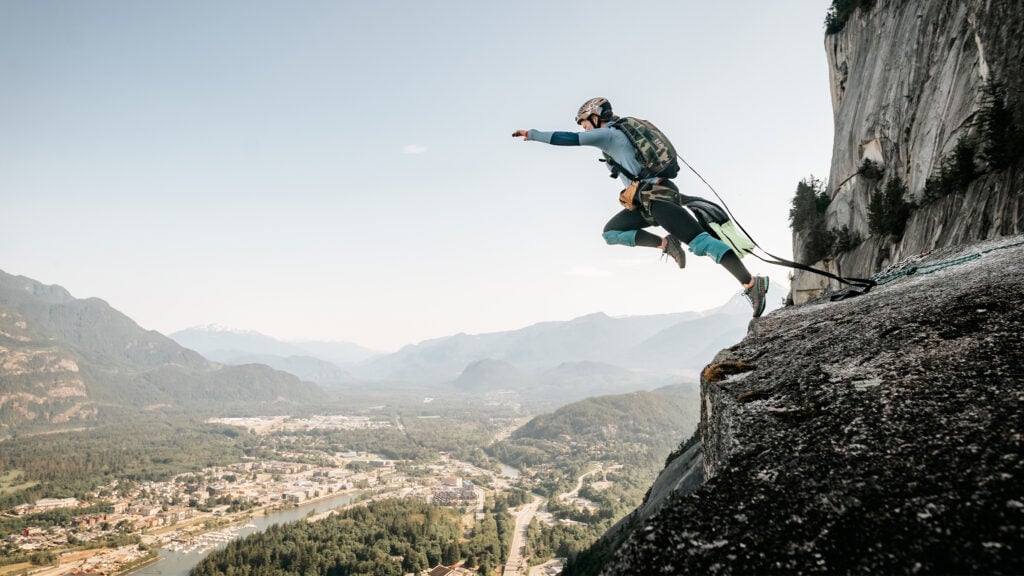On January 22, 2025, I hiked to the top of the Chief, a 2,303-foot granite monolith in Squamish, British Columbia for what I thought would be a casual BASE jump. I’ve done it over 100 times. It’s one of those jumps where you take off, open, fly to the parking lot, and land. There’s only one tricky spot: a corner ledge about 30 meters to the left after you jump—that’s the main hazard to worry about. You don’t want to make a 90-degree turn into that corner.
From the Brink
Do you have a harrowing survival story you’d like to share with Outside? Send it to survivalstories@outsideinc.com.
After two months of traveling and BASE jumping in Patagonia, these would be my first jumps back in British Columbia. The day that I was leaving Chile, I packed my BASE rig in a rush. It was a messy pack job, and I was distracted on the phone with another jumper.
The wind calmed, but with the cross-breeze blowing I thought I should static line—that’s the type of BASE jump where you tie the line that opens your parachute to an anchor on the rock so the action of jumping opens your chute. A static line is a safe way to jump for a windy day or a low jump.

I remembered that this was the pack job from Patagonia and made up my mind. I suggested my friend and I do a two-way jump, where we both leave the cliff at the same time. Since my parachute would open immediately as I jumped, the two of us wouldn’t collide.
We counted down, and, one after the other, we took off. My parachute opened in a 180-degree line twist to the left, and suddenly I was facing the cliff. Because of the twist, any input into the parachute with my control lines was useless.
I don’t know what ultimately went wrong. I assume it was some combination of my hasty pack job and the cross breeze. Maybe I’ll never know.
I reached for my lines but didn’t have time to look up because the wall was so close. I tried to fight it, but there was nothing to fight. I smashed into the wall with my whole body. The rest happened in five seconds. I smashed into the wall, trying to fight the parachute to fix my lines because I had some clearing air-wise. The parachute continued collapsing as I slid down the wall. Then the chute caught air again and I smashed into the wall once more. The crashing and sliding went on for a few seconds as I waited for the final impact. In those moments I knew I was ready to die or get really badly hurt. There was nothing below me but hundreds of meters of air.
Then my parachute caught a tree. I was left hanging—air below me, air around me, nowhere to grab, nowhere to step. My first thought after the chaos died down and I caught my breath was, What am I hanging onto and how long is this going to take? I was in a panic for the next 20 minutes because I didn’t know if my tangled chute was going to hold. I called my boyfriend—he’s a jumper as well—and said he needed to call 911 and get the search and rescue process going. I didn’t know how long I was going to be hanging, I might have gone at any moment.
I heard people above me screaming, and they probably had called for a rescue as well. Within five minutes, I saw cops and firemen below, but they couldn’t get to me from above. I waited—dangling on the line.
I’ve been part of rescues like this before with other jumpers and I knew that it was going to take a long time. I tried to assess my body. I had hurt my knee crashing into the wall and it was swelling up. My next problem was suspension trauma—extended periods in a harness can restrict your blood flow and cause an injury—because I was fully hanging on one leg. I didn’t want to move an inch, because I was scared that if I moved, my parachute could give in and I would fall. I tried to look up at the parachute, but I couldn’t see what it was hanging on. I tried to look at the ledge below me, which was about 100 meters down, and I thought that at least I would have a very clean death if I fell.
After half an hour, my leg started going numb. I knew I had to take the weight off it to get blood flowing. After that much time, I felt better about the stability of whatever I was hanging on, so I pulled up on my risers to put the weight on my arms for a few seconds and immediately felt the blood rush into my leg. Some friends came up to rescue me with ropes on their own, but they decided to wait because they didn’t want to throw a rope that messed with the parachute and could cause me to fall.
It was the longest four hours of my life.
I was just trying to keep my mind occupied counting to 60 slowly ten times, trying to count minutes. Ten minutes of counting was 30 minutes in real time. Words came into my head, something like With the power in my mind I am pushing forward. I probably repeated that line a thousand times. I have no idea where it came from.
I thought of Tomaž Humar, the great Slovenian alpinist and soloist who had a very bad, very famous rescue on Nanga Parbat that took six days. He was wet, cold, and stuck in a snow cave at 21,000 feet. My situation wasn’t even that bad, and he survived with the power of his mind. That’s all I could think of.
Two hours in, my body started to shut down. I just wanted to conserve the energy I needed. I was running out, and then all of a sudden I heard this voice: James, one of the SAR team members.
“Hey Alenka, I know your dad.” He was a few meters away from me. The moment he clipped me in, I felt everything I didn’t feel before. I felt cold. I felt my knee really hurting to the point where I was screaming. I just felt everything. I felt safe.
Alenka Mali walked away from her crash with nothing but a bruised knee. She told Outside that she doesn’t know why she is still alive, but that she believes there must be a reason. —Ed.








